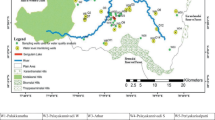Abstract
A method to determine maximum contaminant loading limit in the vicinity of pumping wells is introduced. The method is based on numerical modeling of solute transport applying the adjoint-derived backward equation of the general advection-dispersion equation (backward transport equation). A general idea of the backward transport equation is illustrated and also the compatibility of the equation with the advection-dispersion equation is shown through a numerical test. Then a process to derive contaminant concentration at pumping wells is presented, based on which one can determine the maximum contaminant loading limit to satisfy given criteria of the water quality at pumping wells. This method is applied to a field site in Buk-myeon and Daesan-myeon located in Changwon city, South Korea. The maximum loading limit of nitrate from the potential source loading area near pumping wells in concern is estimated to be 1.95 × 10−2 kg-N/m2 in consideration of denitrification, and 9.55 × 10−3 kg-N/m2 with no regard of it to satisfy the Drinking Water Quality Standard of nitrate in Korea. Since the annual average application rate of total nitrogen fertilizers in Korea is estimated to be 3.54 × 10−2 kg-N/m2, understanding the geochemical condition of the area would be needed to suggest whether to reduce the fertilizer loading rate or not.
Similar content being viewed by others
References
Aller, L., Bennett, T., Lehr, J.H., Petty, R.J., and Hackett, G., 1987, DRASTIC: a standardized system for evaluating groundwater pollution potential using hydrogeological settings. EPA/600/2-87/035, Robert S. Kerr Environmental Research Laboratory, US Environmental Protection Agency, Ada, Oklahoma, 643 p.
Canter, L.W., 1997, Nitrates in Groundwater. CRC Press, Boca Raton, Florida, 288 p.
Cornaton, F., 2003, Deterministic Models of Groundwater Age, Life Expectancy and Transit Time Distributions in Advective-Dispersive Systems. Ph.D. thesis, Center of Hydrogeology, Institute of Geology, University of Neuchâtel, Neuchâtel, Switzerland, 147 p.
Doerfliger, N., Jeannin, P.Y., and Zwahlen, F., 1999, Water vulnerability assessment in karst environments: a new method of defining protection areas using a multi-attribute approach and GIS tools (EPIK method). Environmental Geology, 39, 165–176.
Goldscheider, N., Klute, M., Sturm, S., and Hötzl, H., 2000, The PI method: a GIS based approach to mapping groundwater vulnerability with special consideration of karst aquifers. Zeitschrift Angewandte Geologie, 46, 157–166.
Kim, H.S., Lee, S.I., Bu, S.A., Han, J.S., Hamm, S.Y., Kim, C.S., Jung, K.C., and Park, C.K., 2004, Sustainable Groundwater Development and Artificial Recharge: 21C Frontier R&D Program of “Sustainable Water Resources Research”. Report KIWE-GG-04-1, Korea Water Resources Corporation, Daejon. (in Korean with English summary)
Kim, S.H., Kown, O.O., Kong, I.C., Kim, I.J., Lee, C.H., and Park, Y.K., 1998, A study on groundwater recharge and nitrogen infiltration in a bank filtration site. Journal of Korean Society of Environmental Engineers, 20, 1689–1703. (in Korean with English abstract)
Madl-Szonyi, J. and Fule, L., 1998, Groundwater vulnerability assessment of the SW trans-Danubian central range, Hungary. Environmental Geology, 35, 9–18.
Neupauer, R.M. and Wilson, J.L., 1999, Adjoining method for obtaining backward-in-time location and travel time probabilities of a conservative groundwater contaminant. Water Resources Research, 35, 3389–3398.
Neupauer, R.M. and Wilson, J.L., 2001, Adjoint-derived location and travel time probabilities for a multidimensional groundwater system. Water Resources Research, 37, 1657–1668.
Neupauer, R.M. and Wilson, J.L., 2005, Backward probability model using multiple observation of contamination to identify groundwater contamination sources at the Massachusetts Military Reservation. Water Resources Research, 41, W02015, doi:10.1029/2003WR002974.
Palmer, R.C. and Lewis, M.A., 1998, Assessment of groundwater vulnerability in England and Wales. In: Robins, N.S. (ed.), Groundwater Pollution, Aquifer Recharge and Vulnerability. Geological Society, Special Publications, 130, London, p. 191–198.
Robins, N., Adams, B., Foster, S., and Palmer, R., 1994, Groundwater vulnerability mapping: the British perspective. Hydrogéologie, 3, 35–42.
Sheibley, R.W., Jackman, A.P., Duff, J.H., and Triska, F.J., 2003, Numerical modeling of coupled nitrification-denitrificaion in sediment perfusion cores from the hyporheic zone of the Shingobee River, MN. Advances in Water Resources, 26, 977–987.
Therrien, R., Sudicky, E.A., McLaren, R.G., and Panday, S.M., 2005, HydroGeoSphere: A three-dimensional numerical model describing fully-integrated subsurface and surface flow and solute transport. User’s guide. Groundwater Simulations Group, University of Waterloo, Waterloo, Ontario.
Worrall, F. and Kolpin, D.W., 2003, Direct assessment of groundwater vulnerability from single observation of multiple contaminants. Water Resources Research, 39, 1345, doi:10.1029/2002WR001212.
Author information
Authors and Affiliations
Corresponding author
Rights and permissions
About this article
Cite this article
Lim, JW., Bae, GO. & Lee, KK. Groundwater vulnerability assessment by determining maximum contaminant loading limit in the vicinity of pumping wells. Geosci J 13, 79–85 (2009). https://doi.org/10.1007/s12303-009-0007-3
Received:
Accepted:
Published:
Issue Date:
DOI: https://doi.org/10.1007/s12303-009-0007-3




